Epidemiology Assignment: Calculations and Study Design Analysis
VerifiedAdded on 2023/01/17
|8
|1172
|35
Homework Assignment
AI Summary
This document provides a comprehensive solution to an epidemiology assignment, addressing various aspects of the field. The assignment includes calculations for prevalence, incidence, and mortality rates related to type 2 diabetes and breast cancer. It explores different study designs, such as cross-sectional, longitudinal, and case-control studies, analyzing their applications and distinguishing features. The solution also covers the standardization of incidence rates and its importance in comparing data from different populations. Furthermore, it provides answers to research questions and justifies the selection of appropriate study designs for specific scenarios. Overall, the assignment demonstrates a strong understanding of epidemiological principles and their practical application in public health research. Desklib provides access to this and many other solved assignments and study resources.
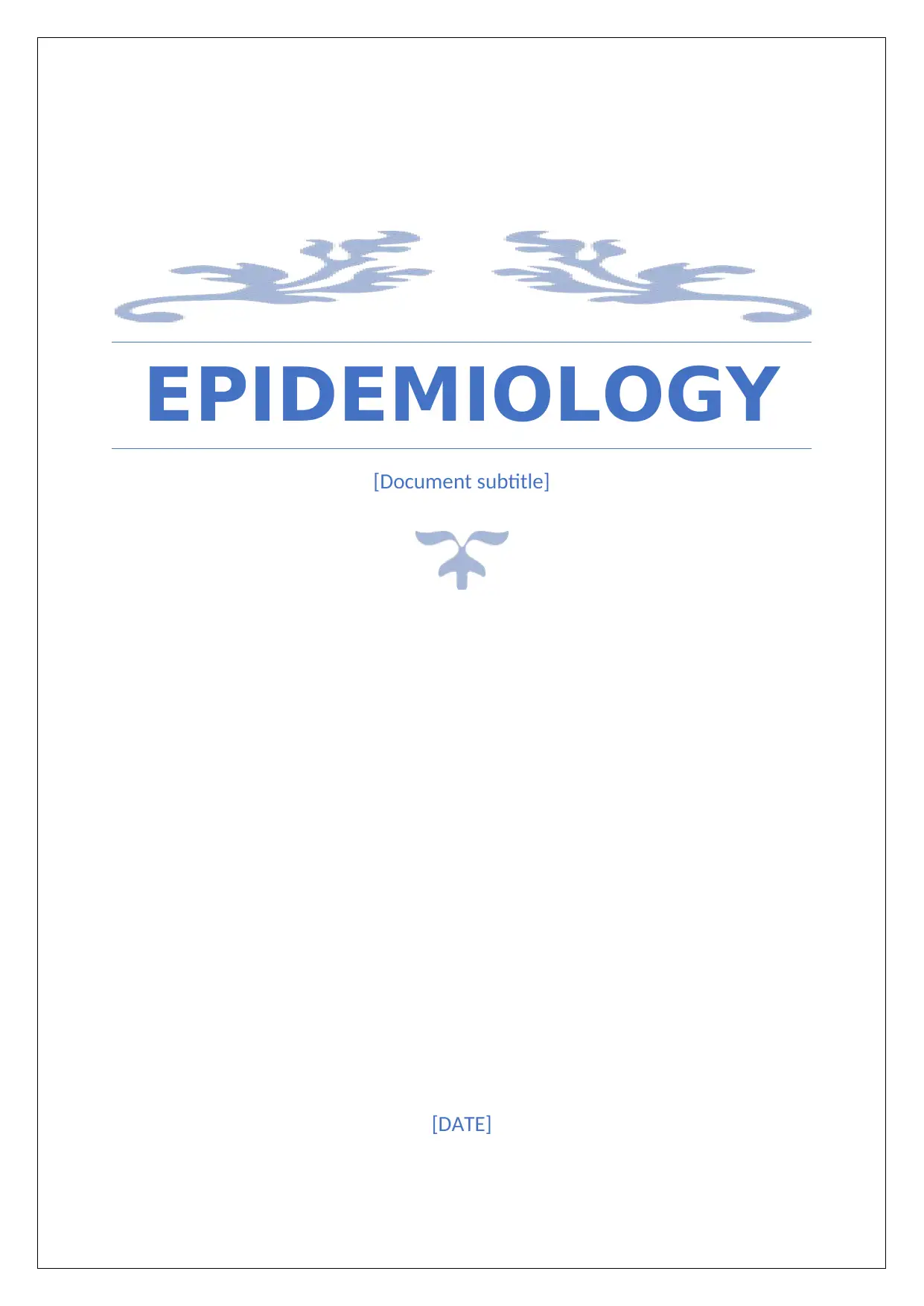
EPIDEMIOLOGY
[Document subtitle]
[DATE]
[Document subtitle]
[DATE]
Paraphrase This Document
Need a fresh take? Get an instant paraphrase of this document with our AI Paraphraser
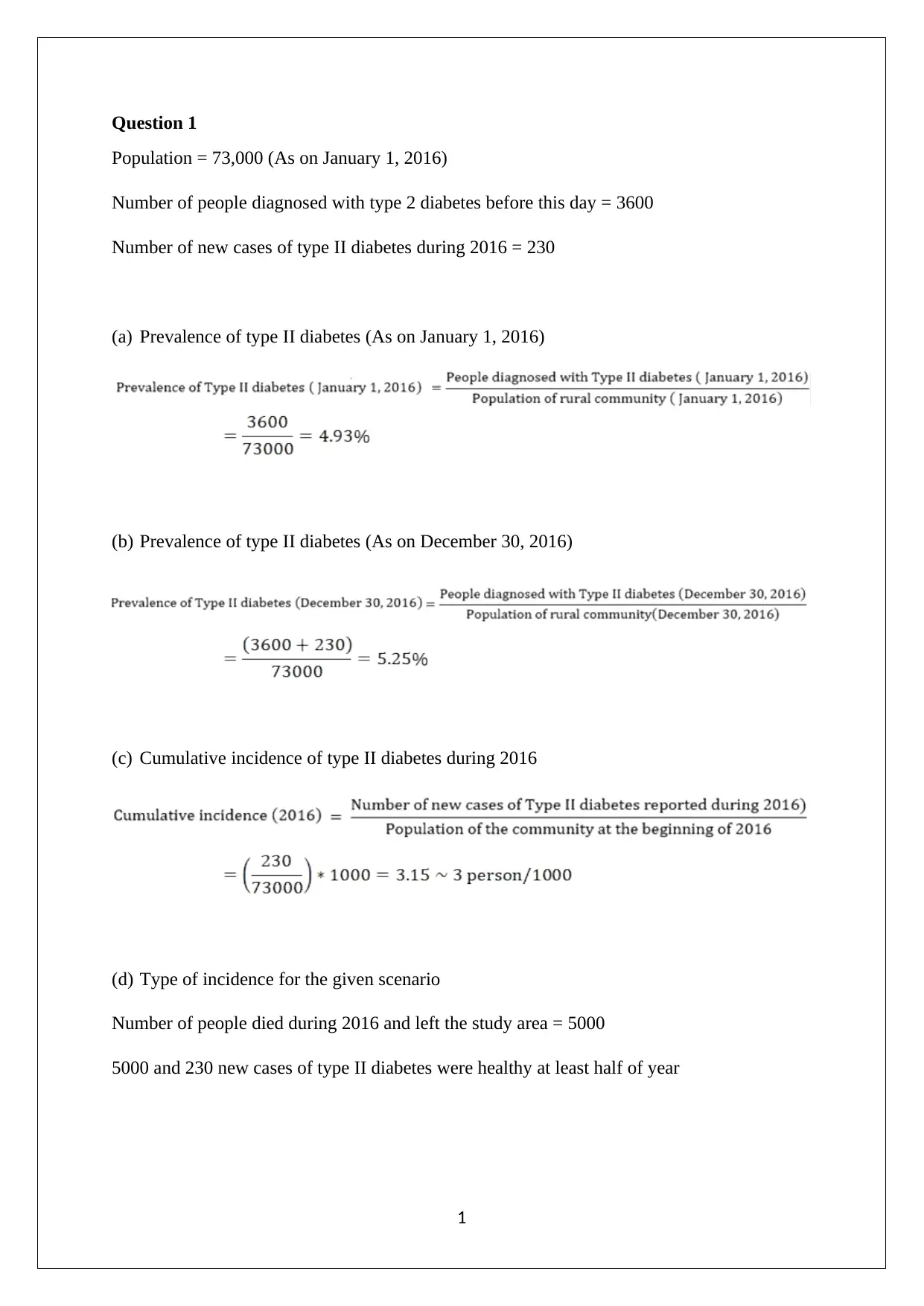
Question 1
Population = 73,000 (As on January 1, 2016)
Number of people diagnosed with type 2 diabetes before this day = 3600
Number of new cases of type II diabetes during 2016 = 230
(a) Prevalence of type II diabetes (As on January 1, 2016)
(b) Prevalence of type II diabetes (As on December 30, 2016)
(c) Cumulative incidence of type II diabetes during 2016
(d) Type of incidence for the given scenario
Number of people died during 2016 and left the study area = 5000
5000 and 230 new cases of type II diabetes were healthy at least half of year
1
Population = 73,000 (As on January 1, 2016)
Number of people diagnosed with type 2 diabetes before this day = 3600
Number of new cases of type II diabetes during 2016 = 230
(a) Prevalence of type II diabetes (As on January 1, 2016)
(b) Prevalence of type II diabetes (As on December 30, 2016)
(c) Cumulative incidence of type II diabetes during 2016
(d) Type of incidence for the given scenario
Number of people died during 2016 and left the study area = 5000
5000 and 230 new cases of type II diabetes were healthy at least half of year
1
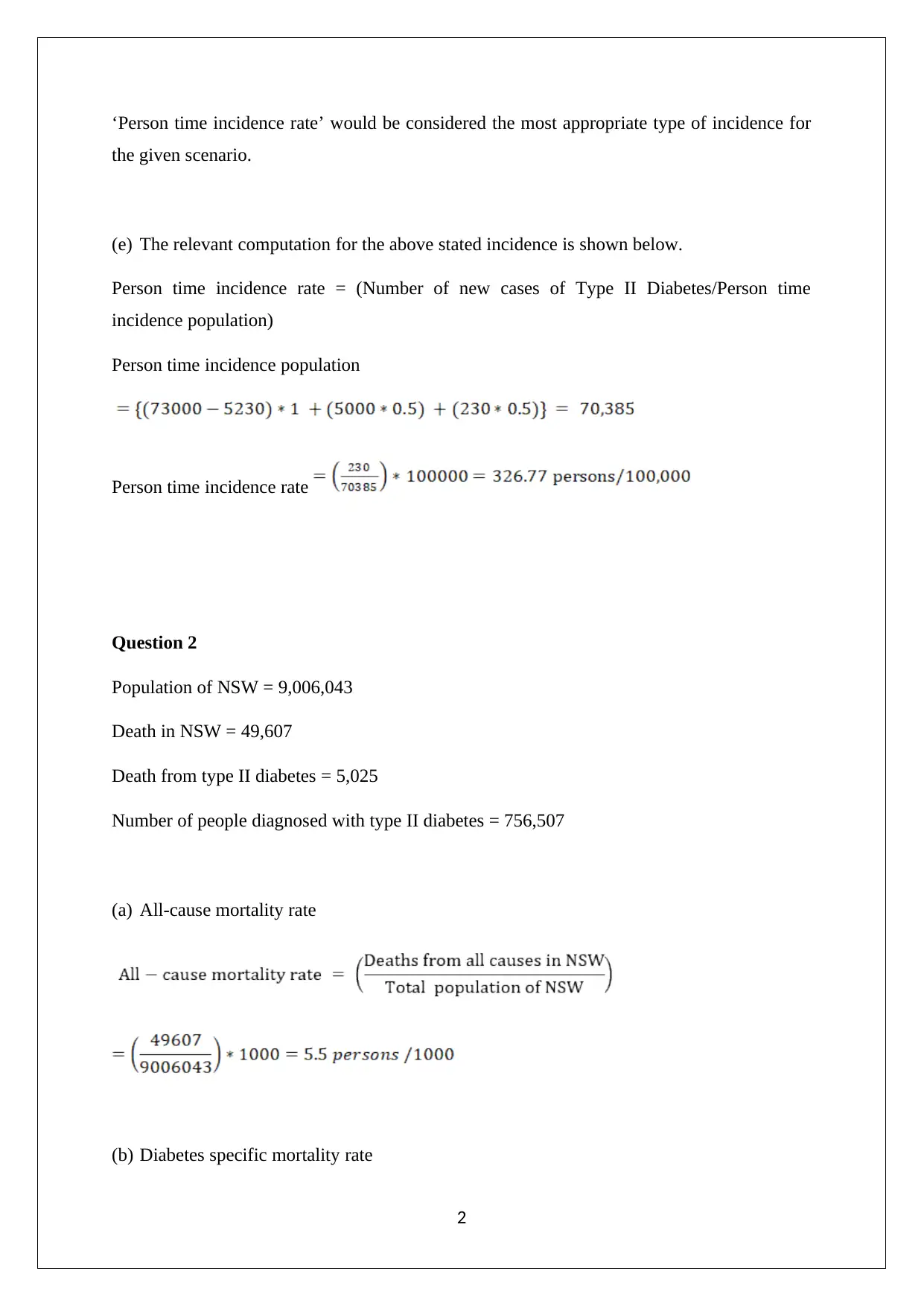
‘Person time incidence rate’ would be considered the most appropriate type of incidence for
the given scenario.
(e) The relevant computation for the above stated incidence is shown below.
Person time incidence rate = (Number of new cases of Type II Diabetes/Person time
incidence population)
Person time incidence population
Person time incidence rate
Question 2
Population of NSW = 9,006,043
Death in NSW = 49,607
Death from type II diabetes = 5,025
Number of people diagnosed with type II diabetes = 756,507
(a) All-cause mortality rate
(b) Diabetes specific mortality rate
2
the given scenario.
(e) The relevant computation for the above stated incidence is shown below.
Person time incidence rate = (Number of new cases of Type II Diabetes/Person time
incidence population)
Person time incidence population
Person time incidence rate
Question 2
Population of NSW = 9,006,043
Death in NSW = 49,607
Death from type II diabetes = 5,025
Number of people diagnosed with type II diabetes = 756,507
(a) All-cause mortality rate
(b) Diabetes specific mortality rate
2
⊘ This is a preview!⊘
Do you want full access?
Subscribe today to unlock all pages.

Trusted by 1+ million students worldwide
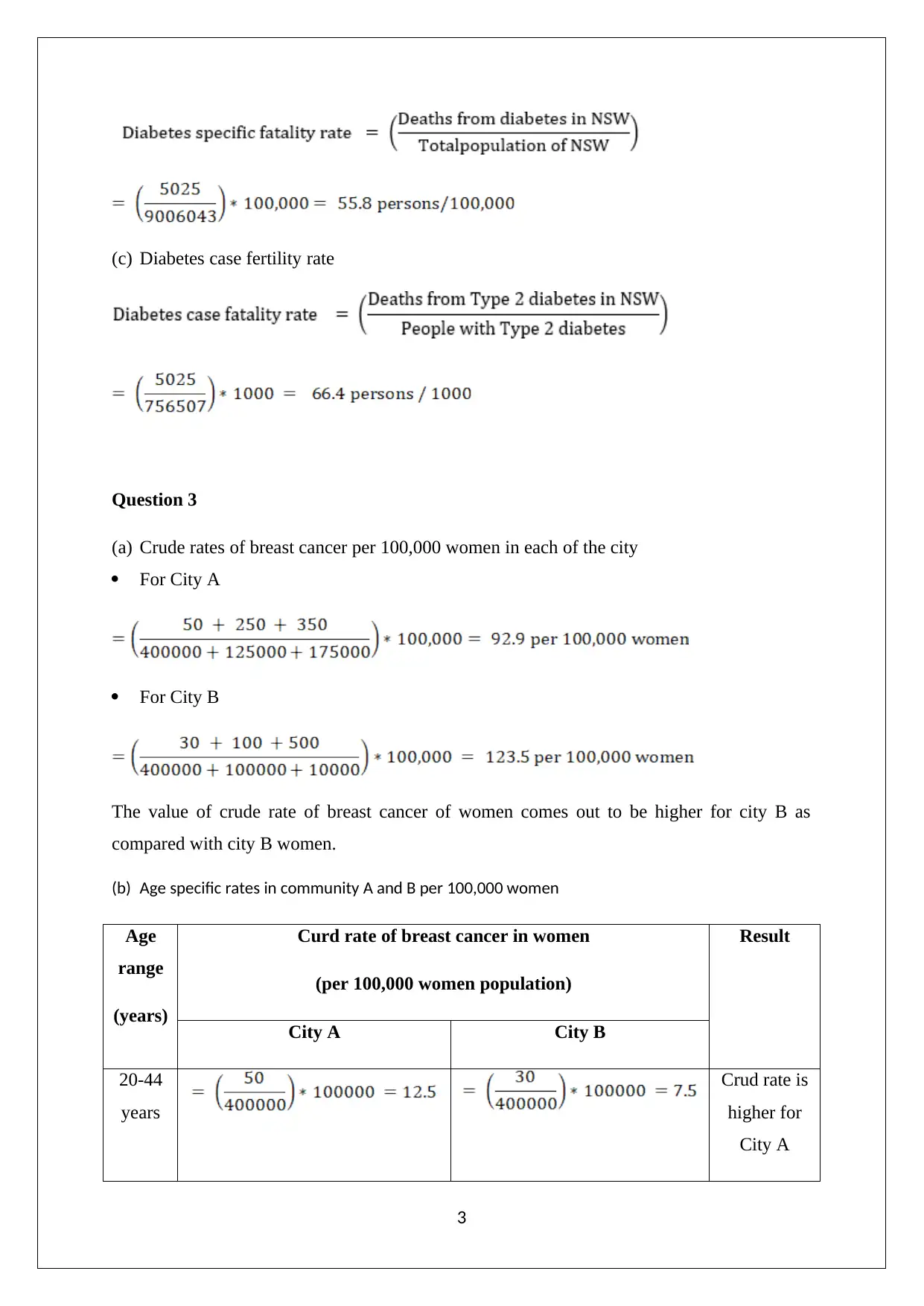
(c) Diabetes case fertility rate
Question 3
(a) Crude rates of breast cancer per 100,000 women in each of the city
For City A
For City B
The value of crude rate of breast cancer of women comes out to be higher for city B as
compared with city B women.
(b) Age specific rates in community A and B per 100,000 women
Age
range
(years)
Curd rate of breast cancer in women
(per 100,000 women population)
Result
City A City B
20-44
years
Crud rate is
higher for
City A
3
Question 3
(a) Crude rates of breast cancer per 100,000 women in each of the city
For City A
For City B
The value of crude rate of breast cancer of women comes out to be higher for city B as
compared with city B women.
(b) Age specific rates in community A and B per 100,000 women
Age
range
(years)
Curd rate of breast cancer in women
(per 100,000 women population)
Result
City A City B
20-44
years
Crud rate is
higher for
City A
3
Paraphrase This Document
Need a fresh take? Get an instant paraphrase of this document with our AI Paraphraser
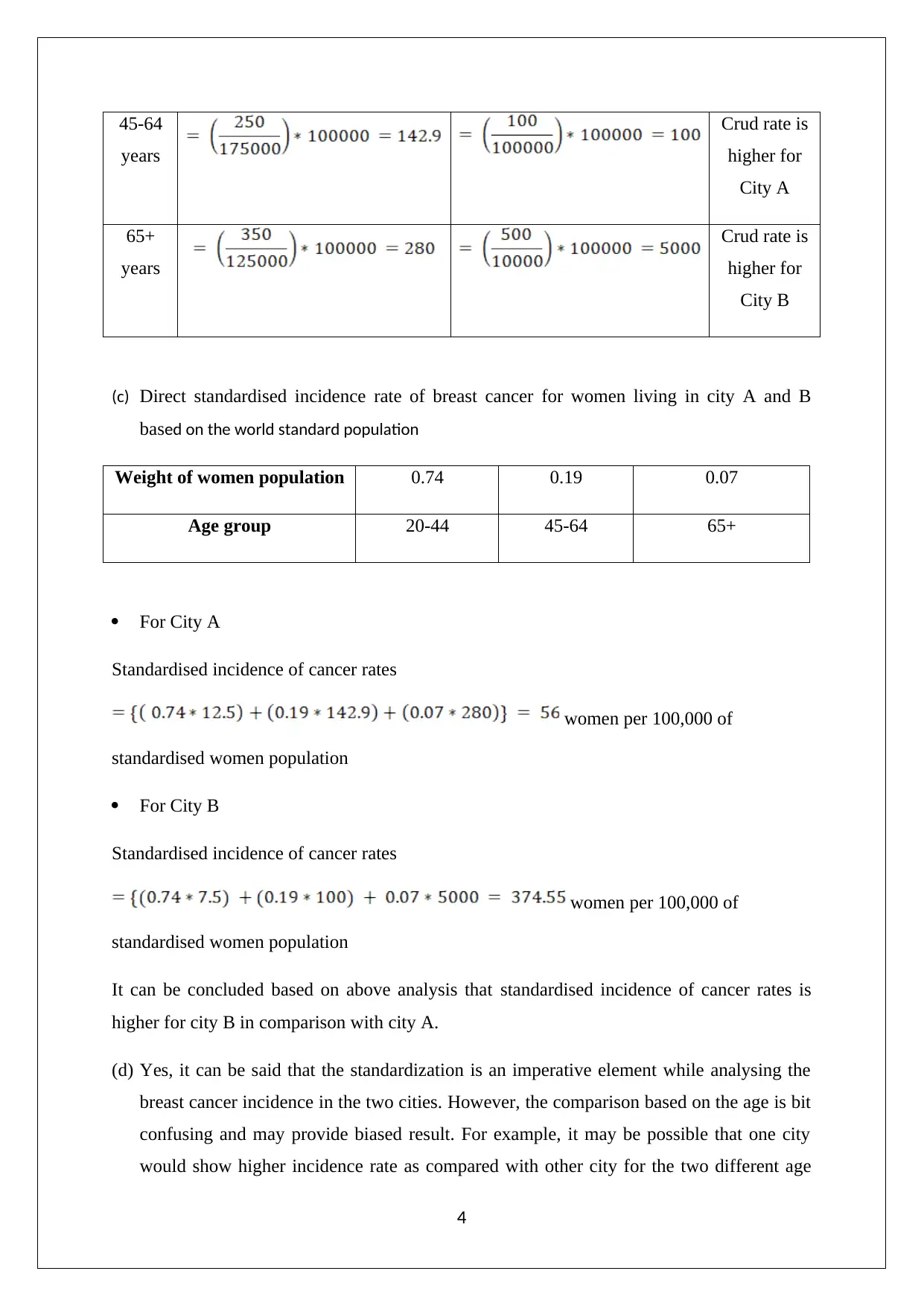
45-64
years
Crud rate is
higher for
City A
65+
years
Crud rate is
higher for
City B
(c) Direct standardised incidence rate of breast cancer for women living in city A and B
based on the world standard population
Weight of women population 0.74 0.19 0.07
Age group 20-44 45-64 65+
For City A
Standardised incidence of cancer rates
women per 100,000 of
standardised women population
For City B
Standardised incidence of cancer rates
women per 100,000 of
standardised women population
It can be concluded based on above analysis that standardised incidence of cancer rates is
higher for city B in comparison with city A.
(d) Yes, it can be said that the standardization is an imperative element while analysing the
breast cancer incidence in the two cities. However, the comparison based on the age is bit
confusing and may provide biased result. For example, it may be possible that one city
would show higher incidence rate as compared with other city for the two different age
4
years
Crud rate is
higher for
City A
65+
years
Crud rate is
higher for
City B
(c) Direct standardised incidence rate of breast cancer for women living in city A and B
based on the world standard population
Weight of women population 0.74 0.19 0.07
Age group 20-44 45-64 65+
For City A
Standardised incidence of cancer rates
women per 100,000 of
standardised women population
For City B
Standardised incidence of cancer rates
women per 100,000 of
standardised women population
It can be concluded based on above analysis that standardised incidence of cancer rates is
higher for city B in comparison with city A.
(d) Yes, it can be said that the standardization is an imperative element while analysing the
breast cancer incidence in the two cities. However, the comparison based on the age is bit
confusing and may provide biased result. For example, it may be possible that one city
would show higher incidence rate as compared with other city for the two different age
4
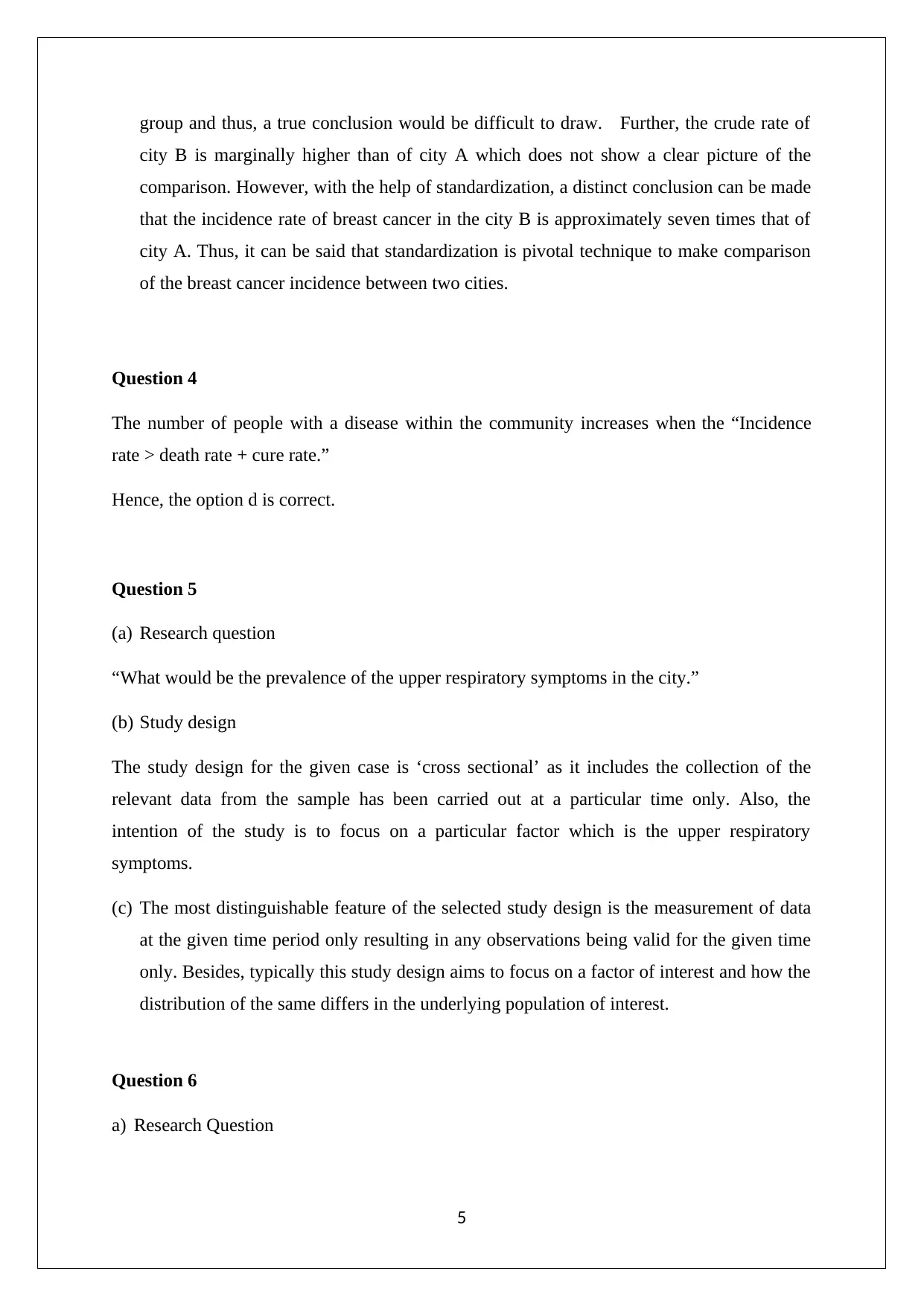
group and thus, a true conclusion would be difficult to draw. Further, the crude rate of
city B is marginally higher than of city A which does not show a clear picture of the
comparison. However, with the help of standardization, a distinct conclusion can be made
that the incidence rate of breast cancer in the city B is approximately seven times that of
city A. Thus, it can be said that standardization is pivotal technique to make comparison
of the breast cancer incidence between two cities.
Question 4
The number of people with a disease within the community increases when the “Incidence
rate > death rate + cure rate.”
Hence, the option d is correct.
Question 5
(a) Research question
“What would be the prevalence of the upper respiratory symptoms in the city.”
(b) Study design
The study design for the given case is ‘cross sectional’ as it includes the collection of the
relevant data from the sample has been carried out at a particular time only. Also, the
intention of the study is to focus on a particular factor which is the upper respiratory
symptoms.
(c) The most distinguishable feature of the selected study design is the measurement of data
at the given time period only resulting in any observations being valid for the given time
only. Besides, typically this study design aims to focus on a factor of interest and how the
distribution of the same differs in the underlying population of interest.
Question 6
a) Research Question
5
city B is marginally higher than of city A which does not show a clear picture of the
comparison. However, with the help of standardization, a distinct conclusion can be made
that the incidence rate of breast cancer in the city B is approximately seven times that of
city A. Thus, it can be said that standardization is pivotal technique to make comparison
of the breast cancer incidence between two cities.
Question 4
The number of people with a disease within the community increases when the “Incidence
rate > death rate + cure rate.”
Hence, the option d is correct.
Question 5
(a) Research question
“What would be the prevalence of the upper respiratory symptoms in the city.”
(b) Study design
The study design for the given case is ‘cross sectional’ as it includes the collection of the
relevant data from the sample has been carried out at a particular time only. Also, the
intention of the study is to focus on a particular factor which is the upper respiratory
symptoms.
(c) The most distinguishable feature of the selected study design is the measurement of data
at the given time period only resulting in any observations being valid for the given time
only. Besides, typically this study design aims to focus on a factor of interest and how the
distribution of the same differs in the underlying population of interest.
Question 6
a) Research Question
5
⊘ This is a preview!⊘
Do you want full access?
Subscribe today to unlock all pages.

Trusted by 1+ million students worldwide
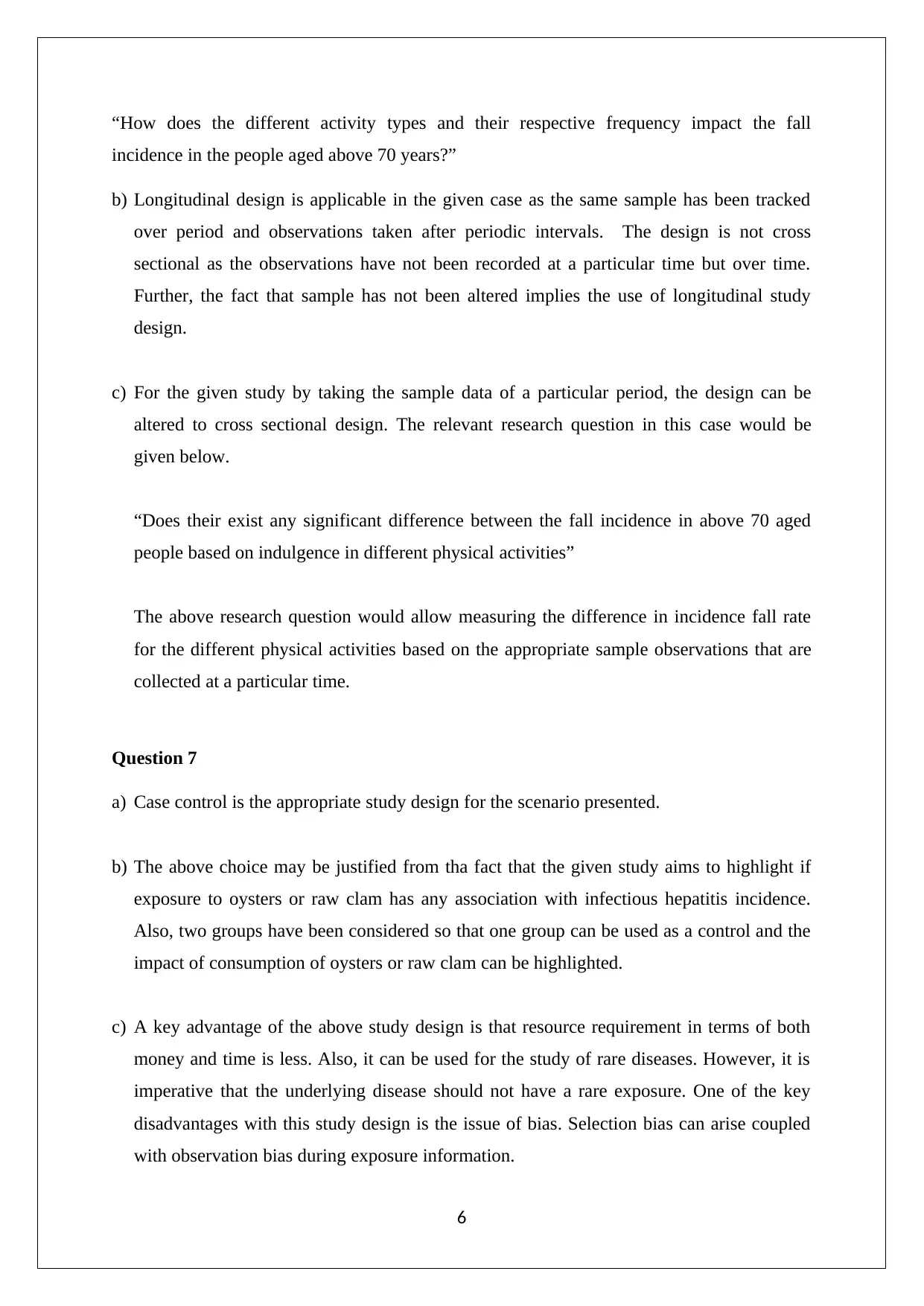
“How does the different activity types and their respective frequency impact the fall
incidence in the people aged above 70 years?”
b) Longitudinal design is applicable in the given case as the same sample has been tracked
over period and observations taken after periodic intervals. The design is not cross
sectional as the observations have not been recorded at a particular time but over time.
Further, the fact that sample has not been altered implies the use of longitudinal study
design.
c) For the given study by taking the sample data of a particular period, the design can be
altered to cross sectional design. The relevant research question in this case would be
given below.
“Does their exist any significant difference between the fall incidence in above 70 aged
people based on indulgence in different physical activities”
The above research question would allow measuring the difference in incidence fall rate
for the different physical activities based on the appropriate sample observations that are
collected at a particular time.
Question 7
a) Case control is the appropriate study design for the scenario presented.
b) The above choice may be justified from tha fact that the given study aims to highlight if
exposure to oysters or raw clam has any association with infectious hepatitis incidence.
Also, two groups have been considered so that one group can be used as a control and the
impact of consumption of oysters or raw clam can be highlighted.
c) A key advantage of the above study design is that resource requirement in terms of both
money and time is less. Also, it can be used for the study of rare diseases. However, it is
imperative that the underlying disease should not have a rare exposure. One of the key
disadvantages with this study design is the issue of bias. Selection bias can arise coupled
with observation bias during exposure information.
6
incidence in the people aged above 70 years?”
b) Longitudinal design is applicable in the given case as the same sample has been tracked
over period and observations taken after periodic intervals. The design is not cross
sectional as the observations have not been recorded at a particular time but over time.
Further, the fact that sample has not been altered implies the use of longitudinal study
design.
c) For the given study by taking the sample data of a particular period, the design can be
altered to cross sectional design. The relevant research question in this case would be
given below.
“Does their exist any significant difference between the fall incidence in above 70 aged
people based on indulgence in different physical activities”
The above research question would allow measuring the difference in incidence fall rate
for the different physical activities based on the appropriate sample observations that are
collected at a particular time.
Question 7
a) Case control is the appropriate study design for the scenario presented.
b) The above choice may be justified from tha fact that the given study aims to highlight if
exposure to oysters or raw clam has any association with infectious hepatitis incidence.
Also, two groups have been considered so that one group can be used as a control and the
impact of consumption of oysters or raw clam can be highlighted.
c) A key advantage of the above study design is that resource requirement in terms of both
money and time is less. Also, it can be used for the study of rare diseases. However, it is
imperative that the underlying disease should not have a rare exposure. One of the key
disadvantages with this study design is the issue of bias. Selection bias can arise coupled
with observation bias during exposure information.
6
Paraphrase This Document
Need a fresh take? Get an instant paraphrase of this document with our AI Paraphraser
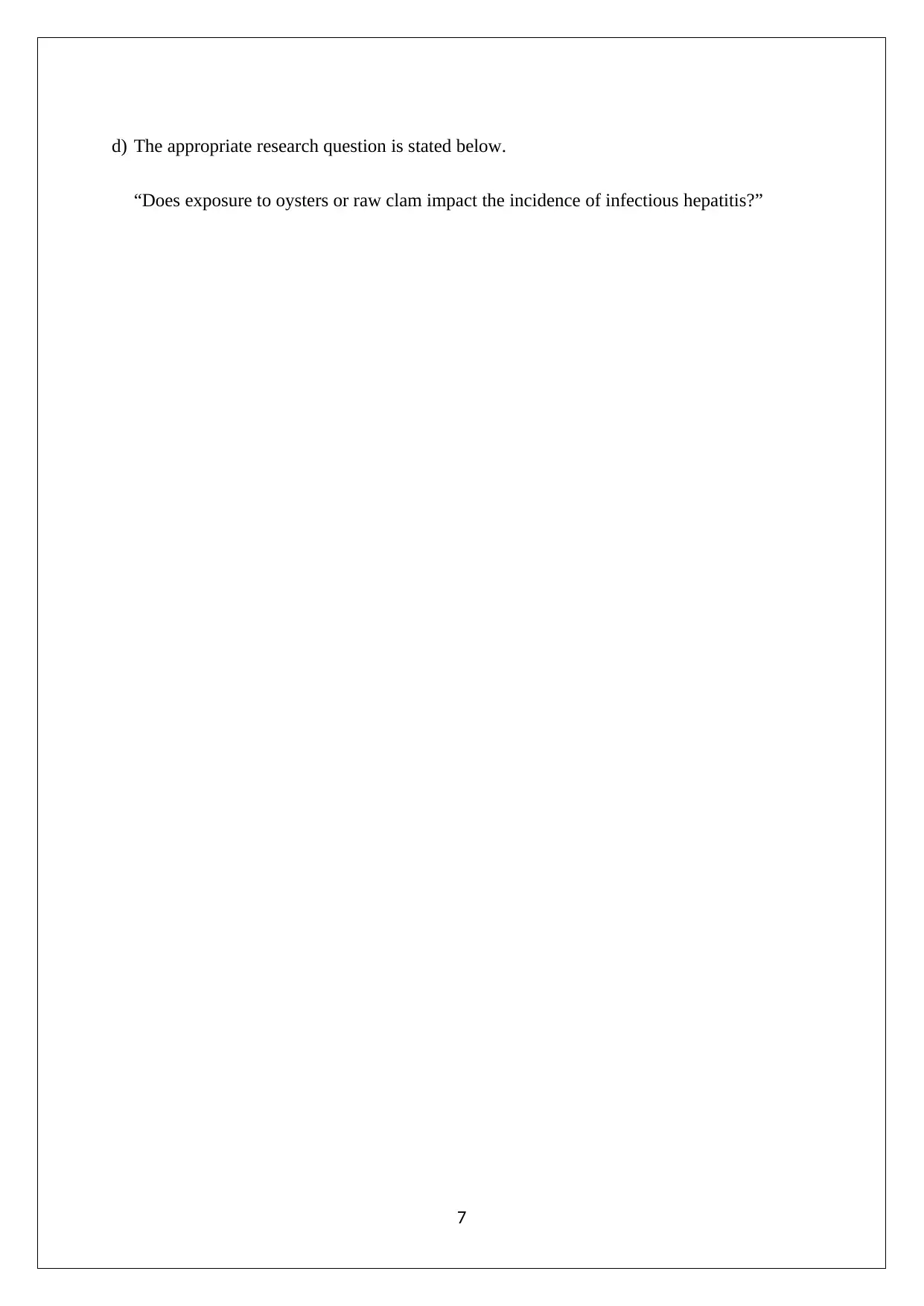
d) The appropriate research question is stated below.
“Does exposure to oysters or raw clam impact the incidence of infectious hepatitis?”
7
“Does exposure to oysters or raw clam impact the incidence of infectious hepatitis?”
7
1 out of 8
Related Documents
Your All-in-One AI-Powered Toolkit for Academic Success.
+13062052269
info@desklib.com
Available 24*7 on WhatsApp / Email
![[object Object]](/_next/static/media/star-bottom.7253800d.svg)
Unlock your academic potential
Copyright © 2020–2025 A2Z Services. All Rights Reserved. Developed and managed by ZUCOL.





